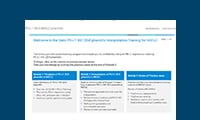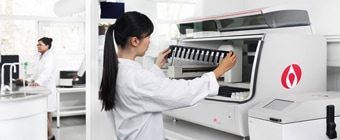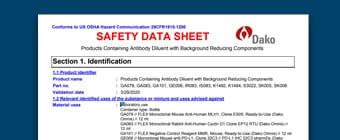PD-L1 IHC 28-8 pharmDx for Gastric, GEJ, and Esophageal Adenocarcinoma


CHECKMATE-649
- It is a phase 3, randomized, multi-center, open-label study in patients with previously untreated, HER2-negative, advanced or metastatic gastric, GEJ, and esophageal adenocarcinoma whose tumors express PD-L1 with a CPS ≥ 5.
- The study results highlight overall survival (OS) benefit from OPDIVO (nivolumab) in combination with fluoropyrimidine and platinum-based chemotherapy.
PD-L1 IHC 28-8 pharmDx is CE-IVD marked and fully validated with analytical performance having met all pre-determined acceptance criteria for sensitivity, specificity and precision.
| Selected analytical validation parameters | Description |
|---|---|
| Specificity |
|
| Sensitivity |
|
| Repeatability |
|
| Reproducibility |
|
OA = Overall Agreement
| Product | Code |
|---|---|
| PD-L1 IHC 28-8 pharmDx | SK005 |
|
Required but not included in kit: Autostainer Link 48 EnVision FLEX Wash Buffer, 20x EnVision FLEX Hematoxylin (Link) PT Link PT Link Rinse Station |
AS480 K8007 K8008 PT101 / PT200 PT109 |
- CHECKMATE-649.
- PD-L1 IHC 28-8 pharmDx Instructions for Use.
- OPDIVO package insert. Manufactured by: Bristol-Myers Squibb Company, Princeton, NJ 08543 USA U.S. License No. 1713.
Intended Use
For in vitro diagnostic use.
PD-L1 IHC 28-8 pharmDx is a qualitative immunohistochemical assay using Monoclonal Rabbit Anti-PD-L1, Clone 28-8 intended for use in the detection of PD-L1 protein in formalin-fixed, paraffin-embedded (FFPE) non-squamous non-small cell lung cancer (nsNSCLC), squamous cell carcinoma of the head and neck (SCCHN), urothelial carcinoma (UC), melanoma, gastric adenocarcinoma, gastroesophageal junction (GEJ) adenocarcinoma, and esophageal adenocarcinoma tissues using EnVision FLEX visualization system on Autostainer Link 48.
PD-L1 protein expression in nsNSCLC, SCCHN, UC, and melanoma is determined by using % tumor cell expression, which is the percentage of evaluable tumor cells exhibiting partial or complete membrane staining at any intensity.
PD-L1 protein expression in gastric adenocarcinoma, GEJ adenocarcinoma, and esophageal adenocarcinoma is determined by using Combined Positive Score (CPS), which is the number of PD-L1 staining cells (tumor cells, lymphocytes, macrophages) divided by the total number of viable tumor cells, multiplied by 100.
Companion Diagnostic Indications
|
Tumor Indication |
PD-L1 Expression Clinical |
Intended Use |
|
Gastric, GEJ, or Esophageal Adenocarcinoma |
CPS ≥ 5 |
PD-L1 IHC 28-8 pharmDx is indicated as an aid in identifying gastric, gastroesophageal junction, or esophageal adenocarcinoma patients for treatment with OPDIVO® (nivolumab) in combination with fluoropyrimidine and platinum-based chemotherapy. |
PD-L1 expression (≥ 1% or ≥ 5% or ≥ 10% tumor cell expression) as detected by PD-L1 IHC 28-8 pharmDx in non-squamous NSCLC (nsNSCLC) may be associated with enhanced survival from OPDIVO® (nivolumab).
PD-L1 expression (≥ 1% tumor cell expression) as detected by PD-L1 IHC 28-8 pharmDx in SCCHN may be associated with enhanced survival from OPDIVO® (nivolumab).
PD-L1 expression (≥ 1% tumor cell expression) as detected by PD-L1 IHC 28-8 pharmDx in urothelial carcinoma may be associated with enhanced response rate from OPDIVO®.
PD-L1 expression (≥ 1% or ≥ 5% tumor cell expression) as detected by PD-L1 IHC 28-8 pharmDx in melanoma may be used as an aid in the assessment of patients for whom OPDIVO® (nivolumab) and YERVOY® (ipilimumab) combination treatment is being considered.
See the local OPDIVO® and YERVOY® product labels for specific clinical circumstances guiding PD-L1 testing.





